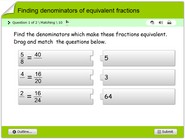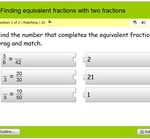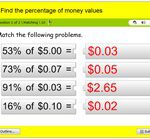Finding denominators of equivalent fractions quiz
Through this quiz you will learn denominators of equivalent fractions online.
Learn to find the missing denominators of equivalent fractions math quiz
In this exercise, learn to find the missing denominators of equivalent fractions. This is a math quiz with interactive online tests to take. At the end of the quiz, the score is displayed. This quiz enables instant feedback so that children can use it as a self-study aid. This also aid teachers and parents to supplement their kid’s lessons. Improve your algebra II skills by playing this online game – Math trive for 3rd, 4th, 5th, 6th and 7th grade children.
A denominator is the bottom number in a fraction. It tells us how many equal parts the whole is divided into. When we have two fractions that represent the same value, we say they are equivalent fractions.
For example, 1/2 and 2/4 are equivalent fractions, because they both represent the same amount, even though they have different numerators and denominators.
When we want to find the denominator of an equivalent fraction, there are a few ways to do it. One of the easiest ways is to use a process called “cross-multiplication.” This method involves multiplying the numerator of one fraction by the denominator of the other fraction, and vice versa.
For example, let’s say we have 1/2 and we want to find an equivalent fraction with a denominator of 6. To use cross-multiplication, we would multiply 1 (the numerator of the first fraction) by 6 (the denominator of the second fraction), and then multiply 2 (the denominator of the first fraction) by 3 (the numerator of the second fraction). This gives us 16 = 6 and 23 = 6.
Now we can set these two numbers equal to each other, 6 = 6. We have now found that the equivalent fraction of 1/2 with a denominator of 6 is 3/6 which is same as 1/2.
Another way to find an equivalent fraction with a denominator of 6, you can multiply the numerator and denominator of the original fraction (1/2) by 3. 1/2 multiplied by 3 is 3/6 which is equivalent fraction.
We can also find equivalent fractions by using the “least common multiple” (LCM) of the denominators. The least common multiple of two numbers is the smallest number that is a multiple of both numbers. In this example, the least common multiple of 2 and 6 is 6, so we can use this as the denominator for the equivalent fraction.
Another way to find the denominator of the equivalent fractions is by dividing the original denominator by the greatest common factor (GCF) of the denominator, and then multiplying it with the numerator.
For example, let’s say we have the fraction 3/4 and we want to find an equivalent fraction with a denominator of 20. To do this, we first need to find the GCF of 4 and 20, which is 4. Then we divide 20 by 4 which gives us 5. Now we multiply 3 with 5 which gives us 15. So, the equivalent fraction is 15/20.
It’s also important to note that dividing a fraction by a fraction is the same as multiplying by its reciprocal. So (3/4) / (5/20) = (3/4) * (20/5) = 3 * 4 = 12/20
It’s also important to note that changing the denominator of a fraction does not change its value. 3/4 is the same as 12/20 and 6/8, etc.
In general, it is important to have a good understanding of fractions to be able to find equivalent fractions with a given denominator. Practice and understanding the properties of fractions, like multiples and common factors, will also help.



